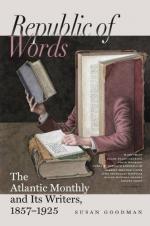We really thought that this shallow philosophy had completely died out, and that every educated person had been brought to comprehend the uses of Beauty and Luxury. Mr. Dexter’s “Street Thoughts” is a silly proof that there are men yet living whose theory of social ethics may apparently be summed up thus: Live meanly, be afraid of God, and listen at keyholes.
The Mathematical Monthly. Edited by J.D. RUNKLE, A.M., A.A.S. Nos. I.-VII. October, 1858, to April, 1859. Cambridge: John Bartlett. 4to. pp. 284.
The title of Mr. Runkle’s Monthly is much drier than its table of contents. He has aimed at interesting all classes of mathematicians, has introduced problems and discussions intelligible to scholars in our High Schools, and has also published contributions to the highest departments of the science. Educational questions have great prominence on the pages of his journal; he gives frequent notes upon the best modes of teaching the elementary branches, and proposes to publish in a serial form treatises adapted to use in the school-room. Every number of the “Monthly” contains five prize problems for students. Nor are its pages confined to topics strictly mathematical. The number for February introduces a problem by a quotation from Longfellow’s “Hiawatha”; another gives a list of fifty-five of the Asteroid group, with their orbits, and the circumstances of their discovery. The March number explains an ingenious holocryptic cipher, written with the English alphabet, with no more letters than would be required for ordinary writing, yet so curiously complicated, that, while with the key easy to understand, it is without the key absolutely undecipherible, even to the inventor of the plan; and the key is capable of so many variations, that every pair of correspondents in Christendom may have their own cipher practically different from all others. In the November and December numbers, a popular account of Donati’s Comet was given by Geo. P. Bond, then assistant, now chief director of the Observatory at Cambridge. This paper has been issued separately, very finely illustrated by twenty-one cuts, and by two beautiful engravings. No papers, readily accessible to the public, contain, in a form so entirely devoid of technicalities, and so clearly illustrated to the eye, so much information relative to the nature of cornels in general, and in particular to the phenomena of this most beautiful comet of the present century.
The purely mathematical articles are all original, many are of great value, and some are, to those who understand their secret meaning, peculiarly interesting. A note of Peirce’s, for example, in the number for February, proposes two new symbols, one for the mystic ratio of the circumference to the diameter, a second for the base of Napier’s logarithms,—and then, by joining them in an equation with the imaginary symbol, expresses in a single sentence the mutual relation of the three great talismans in the magic of modern science. Another article, in the April number, by Chauncey Wright, contains a new view of the law of Phyllotaxis, approaching it from an a priori stand-point, and showing that the natural arrangement of leaves about the stems of plants is precisely that which will keep the leaves most perfectly distributed for the reception of light and air.




